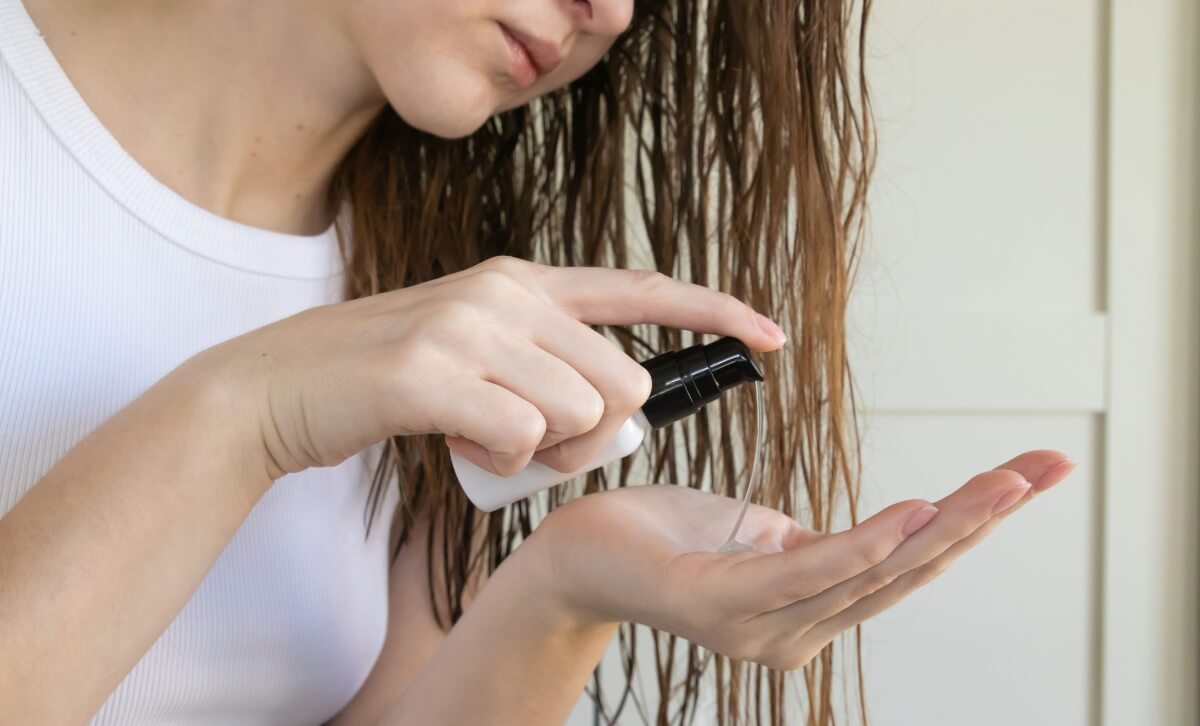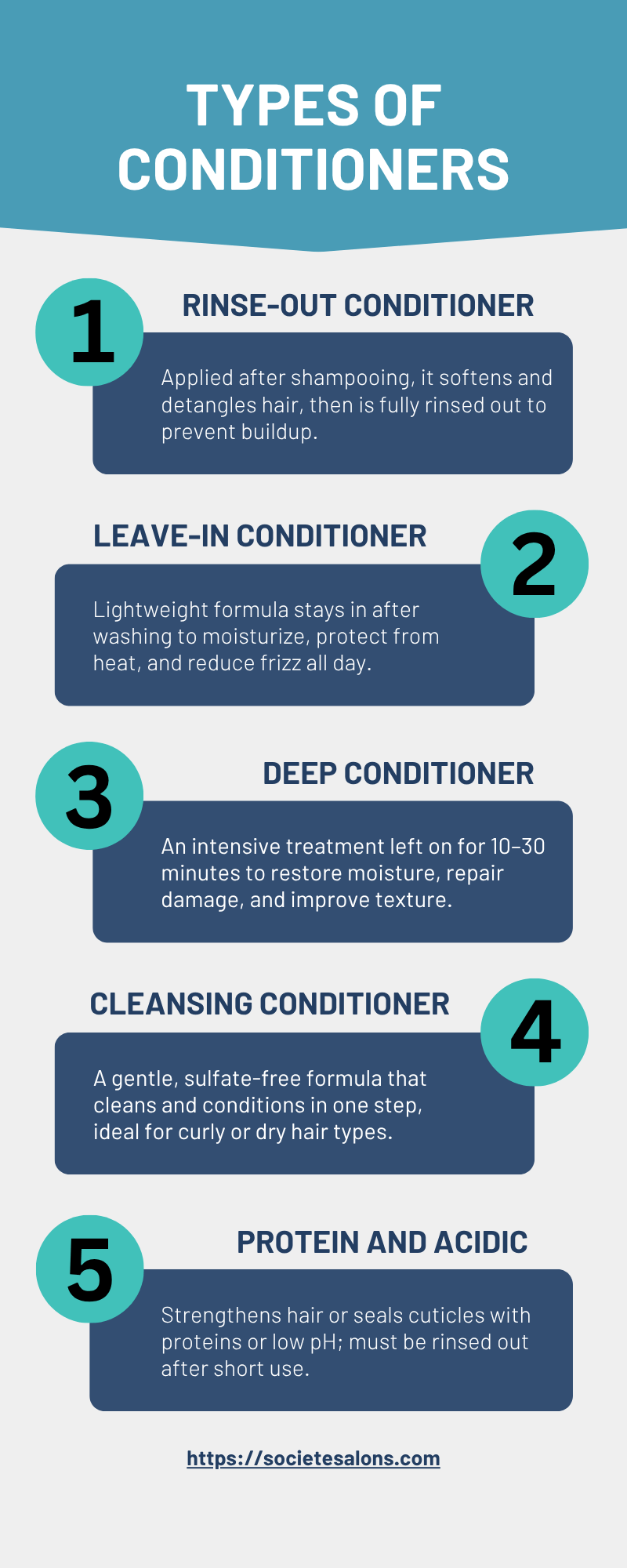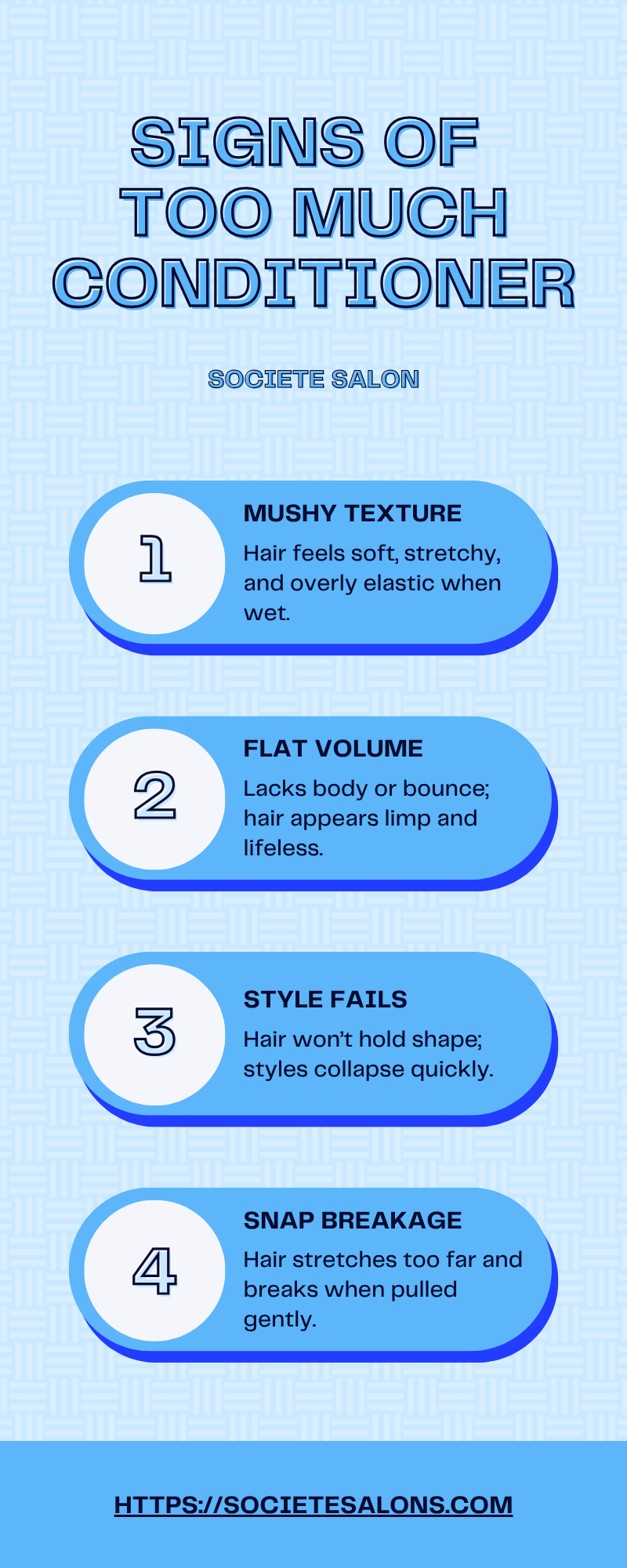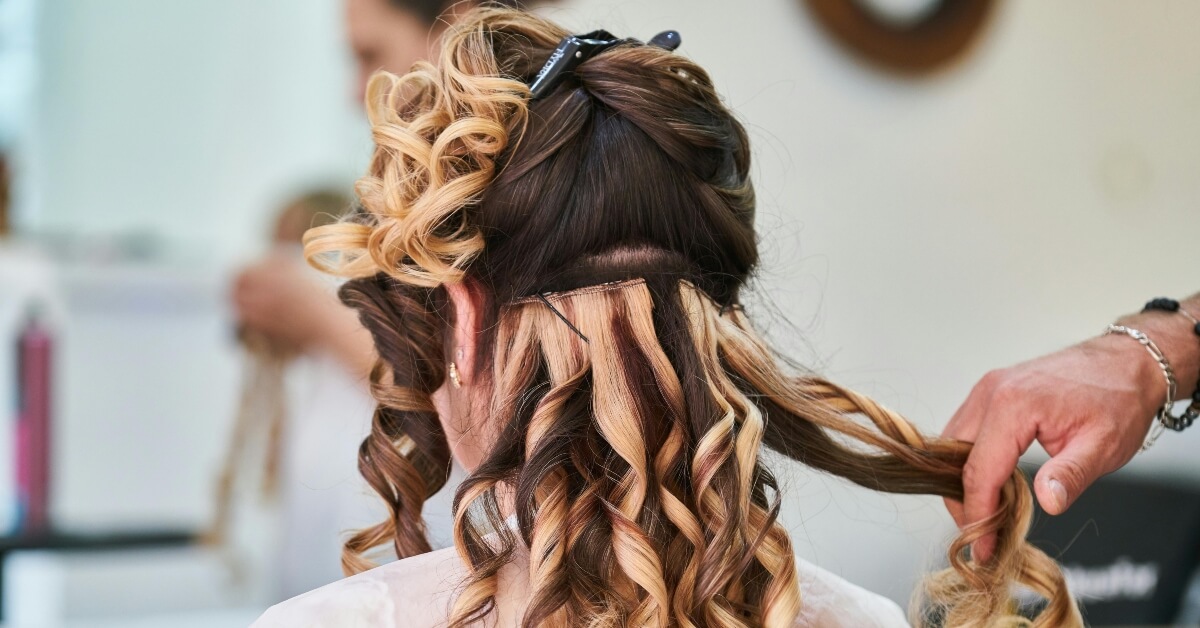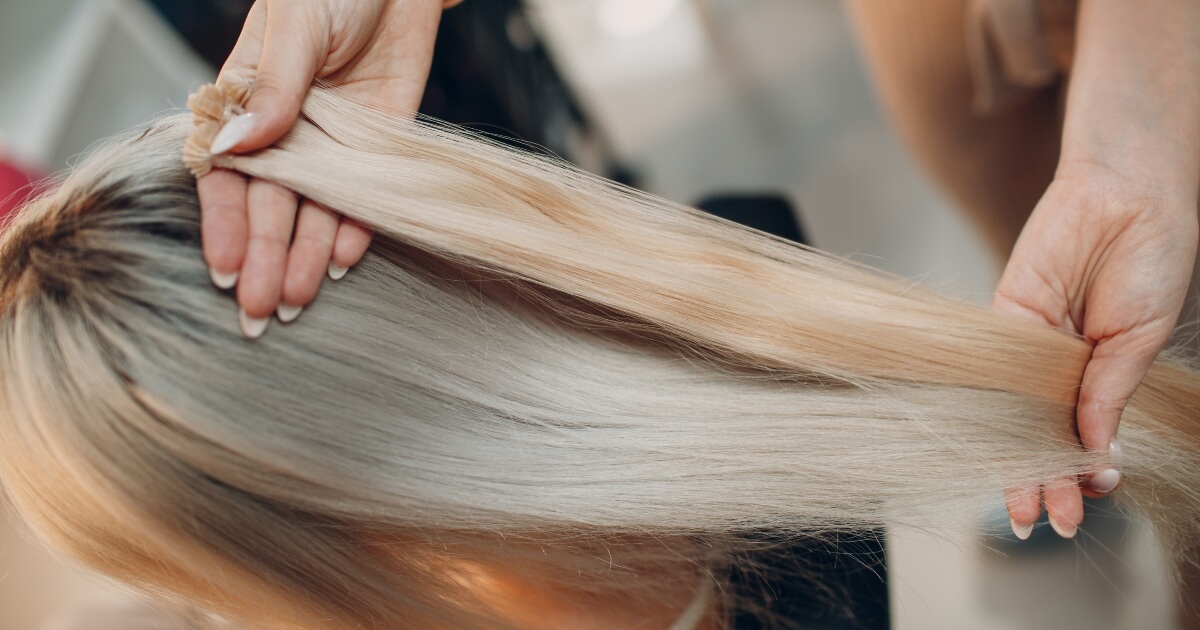Conditioner can moisturize and protect your hair from heat, but like all good things, using it too often or in the wrong way can cause damage. For example, leaving conditioner in your hair for too long is usually a bad idea.
Our blog takes a comprehensive look at hair conditioners and answers the question: what happens when you leave conditioner in your hair?
If your hair was damaged by conditioner or you need hair care tips from experts, contact Societe Salon. We have locations in North Palm Beach and Jupiter and our experienced stylists have an unwavering commitment to hair excellence, both in the salon and at home.
Schedule your appointment today so the elite stylists at Societe Salon can deliver beauty with confidence.
How Do Hair Conditioners Work?
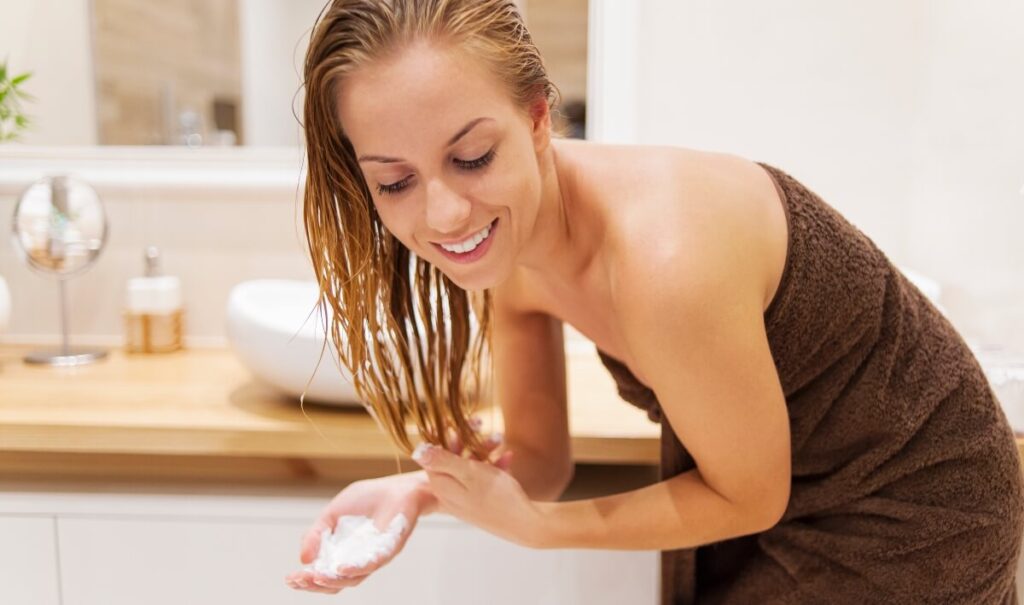
Conditioner helps nourish your hair and protect it from heat and pollution, which can cause significant damage. Conditioner is sort of like moisturizer for your hair.
Conditioners contain oils, silicones, emollients and cationic surfactants, which are positively-charged compounds that attach themselves to your hair, creating a temporary coating that has numerous benefits, including:
- Smoothing out the cuticle, which is the outer layer of your hair
- Reducing static electricity that can cause frizz
- Filling in damaged areas of your hair strands
- Softening your hair, which can make it easier to comb through and style
- Giving your hair a shiny appearance
Conditioner mainly works on the cuticle, which is the outermost layer of each strand of hair. Heat styling tools, chemical treatments and your environment can lift the cuticle and leave the cortex (middle layer of hair) vulnerable to damage. The cortex contains proteins that give your hair strength and color.
Hair conditioner seals and smooths out the cuticle. Some conditioners also have ingredients that penetrate beyond the cuticle to provide moisture and nutrients to the cortex. This process builds the internal strength of your hair.
What Happens When You Leave Conditioner in Your Hair?
Are you risking damage to your hair if you leave conditioner in your hair longer than the directions on the bottle? What if you did not rinse the conditioner out completely?
Here are some of the potential side effects of leaving conditioner in your hair:
For Most Rinse-Out Conditioners
If you’re using a regular rinse-out conditioner (the kind most of us have in our showers), here’s what might happen.
If you leave it in for a few extra minutes:
- Extra Moisture: Your hair might absorb a bit more moisture, which could be a good thing if you have unusually dry or damaged hair.
- Increased Softness: Your hair might feel extra soft immediately after washing out the conditioner.
- Detangling May be Easier: The longer the conditioner sits in your hair, the more time it has to coat each strand. This can help make it easier to detangle your hair.
If you leave the conditioner in for a few hours or overnight:
- Product Buildup: The conditioner can start to attract dirt and dust from the environment.
- Limp, Flat Hair: The extra weight on your hair can pull it down, reducing your hair’s volume.
- Greasiness: As the product sits, it can make your hair look unwashed and oily.
- Altering Your Scalp’s pH: Many conditioners have a slightly acidic pH, allowing the product to seal the cuticle. Leaving conditioner in for an extended period can alter the pH balance of your scalp.
In you repeatedly leave conditioner in your hair, you may experience:
- Scalp Irritation: A buildup of conditioner can clog hair follicles, possibly causing irritation or folliculitis.
- Weakened Hair: Too much moisture can cause hygric fatigue, which is when your hair repeatedly swells and contracts. This can weaken your hair strands.
- Dull Hair: Eventually, conditioner buildup creates a barrier that keeps moisture and nutrients out of your hair shafts.
- Bacterial Growth: Bacteria or fungus could grow on your scalp.
- Altered Hair Texture: Too much moisture can cause changes to your hair’s texture and elasticity.
While there can be some potential benefits to leaving conditioner in your hair every now and then, most conditioners are formulated to be washed out. If you don’t follow the instructions, you’re risking damage to your hair.
Understanding the Chemistry Behind Leaving Conditioner in Your Hair
Most conditioners contain the following chemicals:
- Cationic Surfactants: These positively charged molecules attach to hair but can accumulate over time.
- Silicones: These help to give your hair a smooth coating, but they can easily build up if you use conditioner too often.
- Fatty Alcohols: These help to moisturize your hair, but can weigh your hair down if they are used too often.
- Humectants: These attract water to your hair, but overuse can bring excessive moisture.
When you leave these ingredients on your hair strands for too long, your hair is going to attract water, dust, and oil from the environment. These elements are going to weigh your hair down and trap moisture on your scalp.
What You Need to Know About the Different Kinds of Conditioners
Now that you understand what can happen if you leave regular conditioner in your hair, let’s talk about the different types of conditioners and how you’re supposed to use each one.
Rinse-Out Conditioners (Daily Conditioners)
These are your standard, everyday conditioners that you use after shampooing. You apply the conditioner to wet hair, focusing on the mid-lengths to ends, leave it in for 1-5 minutes, then rinse it out completely. They’re perfect for regular maintenance and adding moisture after you shampoo your hair.
Almost everyone can use daily conditioners, but make sure to choose a formula that matches your specific hair type. If you have fine hair, only apply conditioner to the ends of your hair since this prevents the product from weighing down your roots. These conditioners contain moderate levels of conditioning agents that stick to your hair shaft and are designed to be mostly rinsed away, leaving just enough product behind to make your hair soft and manageable.
What Happens if You Leave Daily Conditioners In?
You’ll get product buildup on your hair and scalp, heavy and limp hair that lacks volume, a greasy appearance, and possible scalp irritation.
Leave-In Conditioners
These lightweight formulas are specifically designed to stay in your hair after you wash it. You apply them to damp hair after washing, focusing on the mid-lengths and ends, but you don’t rinse this type of conditioner out.
Leave-in conditioners are great for:
- Extra moisture
- Detangling
- Heat protection
- Frizz control
- People with dry, damaged, curly, or frizz-prone hair
- People who frequently use heat-styling tools
When you leave these products in as intended, your hair stays moisturized throughout the day, gets protection from environmental damage, becomes easier to style with less frizz, and experiences less breakage and fewer split ends.
Here’s the thing about leave-in conditioners – less is more! Start with a small amount and add more if you need it because too much can weigh down your hair. They have a higher water content and lower concentration of conditioning agents than rinse-out products, so they’re designed to be absorbed by your hair without creating buildup. Many also protect your hair from pollution, UV rays, and heat styling throughout the day.
Deep Conditioners and Hair Masks
- These are intensive treatments with higher concentrations of conditioning ingredients. You apply them to wet hair after shampooing, leave for 10-30 minutes depending on the product instructions, then rinse thoroughly.
- They’re best for repairing damage, restoring moisture, and improving your hair’s overall condition. That’s why people who have damaged, dry, processed, or textured hair get the most benefit from these treatments.
- For even deeper conditioning, cover your hair with a shower cap or warm towel while the mask works. The heat helps the conditioner penetrate more deeply into your hair.
- But what happens if you leave them in too long? You’ll get product buildup, “moisture overload” which can damage your hair, limp and flat hair, and a greasy appearance.
Cleansing Conditioners (Co-Wash)
These hybrid products clean and condition your hair at the same time, usually without harsh sulfates.
Here are some of the main takeaways you should know:
- You apply cleansing conditioners to wet hair, massage into your scalp and hair, then rinse thoroughly.
- They’re perfect for gentle cleansing between regular washes, especially if you have curly or coily hair.
- People with curly, coily, or very dry hair benefit most from co-washing, though they’re not ideal if you have fine or oily hair. These types of hair require more scrubbing action than regular shampoo – you need to massage your scalp with your fingertips to effectively cleanse your hair. They use mild surfactants that clean without stripping your hair while conditioning it at the same time, relying on the mechanical action of massaging your scalp to lift away dirt and oils rather than harsh detergents.
If you leave cleansing conditioners in, you’ll get scalp buildup, possible irritation, and a flat, greasy appearance.
Protein Conditioners
These conditioners contain protein like keratin, wheat, or rice to strengthen your hair. You apply them after shampooing, leave for 3-5 minutes or follow the directions, then rinse thoroughly. They’re best for strengthening damaged or over-processed hair.
Who Benefits From These Conditioners?
People with damaged, chemically treated, or naturally porous hair should use these treatments. Balance is key with protein treatments though – too much protein can make your hair brittle, while too little can leave it weak. You should alternate protein treatments with moisturizing ones.
How do These Conditioners Work?
These conditioners temporarily repair damaged areas of your hair shaft by filling in gaps in the cuticle with proteins that have been broken down into small molecules. The proteins attach to your hair shaft, strengthening it from the outside.
Your hair needs a balance of protein and moisture, so if your hair feels stiff or brittle, it may have too much protein. If it feels mushy or stretches too much when wet, it may need more protein.
Leave them in too long and you risk protein overload which can damage your hair, make your hair feel stiff or brittle, and cause increased breakage.
Acidic Conditioners and Treatments
These products have a low pH, typically between 3.5-5.5, and are designed to seal the cuticle. You apply them after shampooing or coloring, leave for 1-5 minutes, then rinse. They’re best for sealing the cuticle after color treatments, adding shine, and reducing frizz.
Who Should Use Them?
People who color their hair, have high porosity hair, or struggle with frizz get the most benefit from acidic treatments.
How do Acidic Conditioners Work?
They work by lowering the pH of your hair, which causes the cuticle to contract and lie flat. This creates smoother, shinier hair and helps preserve color by sealing the cuticle.
Leave them in too long and you risk over-acidification of your scalp, your hair may become too rigid, and you might experience irritation.
Can You Leave Conditioner in Your Hair? What Does the Research Say?
When it comes to leaving conditioners in hair for extended periods, research and professional experience show varied results depending on what type of product you’re using.
Regular Rinse-Out Conditioner Left in Overnight
If you accidentally leave regular conditioner in your hair overnight, you’ll wake up with flat, greasy-looking hair that feels heavy and may require multiple washes to feel clean again. There’s actually research backing this up – a 2019 study in the Journal of Cosmetic Science found that residual conditioner left on hair for extended periods created a film that attracted up to 30% more environmental pollutants than properly rinsed hair.
Bottom line? Definitely not recommended!
Leave-In Conditioner Used as Directed
When you use leave-in conditioners the way they’re supposed to be used, you get soft, manageable hair with reduced frizz throughout the day. A consumer study with 500 participants found that proper use of leave-in conditioners reduced breakage by up to 47% compared to using no treatment at all.
This is exactly why leave-in conditioners exist – when used as intended, these provide excellent benefits for your hair.
What Happens When You Leave Deep Conditioner In Too Long?
Let’s say you leave a deep conditioner in for 2 hours instead of the recommended 30 minutes. Your hair will typically feel slightly over-conditioned and look a bit limp, though it will be very soft. Here’s what’s interesting though – instrumental analysis shows that most deep conditioners reach maximum penetration within 30 minutes with heat, or 45 minutes without heat. Any additional time provides minimal benefit.
The takeaway? More isn’t always better when it comes to conditioning treatments. Follow the timing instructions on your products.
Cleansing Conditioner Without Proper Rinsing
If you don’t rinse cleansing conditioners properly, your scalp often becomes itchy and your hair looks unwashed. Dermatological studies have actually linked improper removal of cleansing conditioners to an increase in folliculitis cases, particularly in people with fine hair or sensitive scalps.
These products need to be rinsed thoroughly to work the way they’re supposed to.
The Problem with Leaving Protein Conditioner In Too Long
When protein conditioners are left in longer than recommended, your hair often becomes stiff, brittle, and prone to breakage. Laboratory testing demonstrates that excessive protein exposure can disrupt your hair’s natural protein structure, leading to decreased elasticity.
With protein treatments, more is definitely not better. You should follow timing instructions precisely to avoid damaging your hair.
The Benefits of Leaving-In the Right Conditioners
It’s risky to leave conditioner in your hair for too long, unless you’re using a product that was specifically designed to be left in. Here are some of the main benefits of leave-in conditioners.
Your Hair Stays Moisturized All Day
Leave-in conditioners hydrate your hair throughout the day. This is a huge benefit to people with dry, curly hair. Moisturizing your hair prevents it from absorbing humidity from the environment. Humidity causes frizz.
Protection From Heat Styling
Many leave-in conditioners contain ingredients that help protect your hair from heat styling tools.
These ingredients create a barrier between your hair and heat. You get less damage when you use your blow dryer, flat iron, or curling iron.
Less Breakage and Fewer Split Ends
Leave-in conditioners reduce friction between hair strands. This means less breakage and fewer split ends. Fine or fragile hair benefits the most from this.
Makes Detangling Easier
Leave-ins make combing through wet or dry hair much easier. They reduce the risk of breakage during styling. The slip from these products allows combs and brushes to glide through knots. You won’t pull or tear your hair.
Your Hair Gets UV Protection
Some leave-in products contain ingredients that shield your hair from sun damage. Your hair can get UV damage just like your skin. UV damage leads to color fading, dryness, and weakened strands.
Leave-in conditioners protect your hair in other ways too:
• Environmental Protection: Many create a barrier that protects hair from pollutants, smoke, and other contaminants that can dull hair.
• Color Protection: Leave-in conditioners with UV filters help preserve your color and prevent fading. They create a film that helps lock in color molecules.
• Saves Time: Using leave-in conditioners combines multiple benefits into one step. This saves you time and reduces the number of products you need.
Choosing the Right Conditioner for Your Hair Type
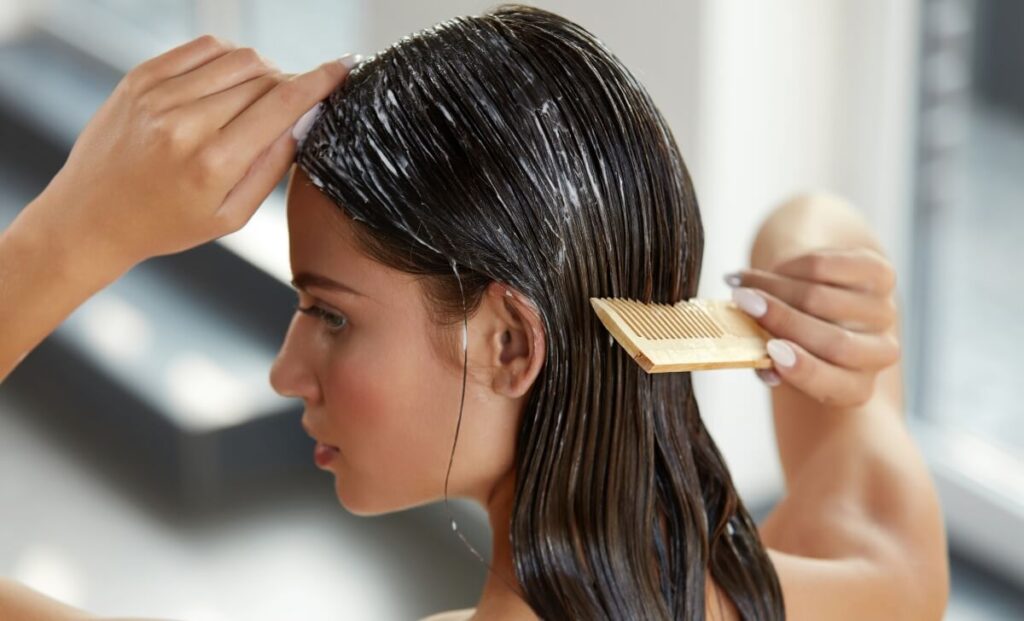
The most important thing to think about when choosing the right conditioner is your hair type.
Fine Hair
Avoid heavy products because they are going to weigh down your hair and make it look flat. Stick with lightweight, volumizing rinse-out conditioners or mousse-like formulas. If you need more moisture, use a water-based leave-in conditioner.
How to Apply Conditioner to Fine Hair
Put the conditioner on the ends of your hair. Keep it off your roots. Use a wide-tooth comb to distribute the product evenly, then rinse with cool water to seal the cuticle.
Don’t use regular rinse-out conditioners. If you need a leave-in product, choose one specifically designed for fine hair and apply it to towel-dried hair to prevent weighing it down.
Fine hair tends to get oily at the roots and needs moisture at the ends. Fine hair has a higher risk of product buildup, so you may need to use a clarifying treatment once every two weeks.
When you’re shopping for conditioner, check the ingredient list for things like rice protein or bamboo extract, which can add volume to your hair. Stick with products that contain glycerin or aloe vera, which are much lighter than butters and oils.
Thick Hair
Thick hair can handle much more product than fine hair. You’ll want rich, moisturizing rinse-out conditioners, cream-based leave-ins, and regular deep conditioning treatments to keep your hair healthy.
You can apply conditioner from mid-shaft to ends, and you’ll probably need to work in sections for better coverage. Use a wide-tooth comb to distribute the product evenly throughout your hair.
Thick hair can tolerate longer conditioning times, though you should still follow the product instructions. You might benefit from layering multiple conditioning products, and you can use heavier leave-in formulas without worry.
Special Considerations for Thick Hair:
- Thick hair often requires more product, so budget accordingly
- It may take longer for products to fully penetrate your hair shaft
- Consider using heat with a shower cap or hooded dryer to help deep conditioners work better
Look for heavier moisturizers like shea butter or coconut oil, humectants like honey or glycerin, and proteins for strength if your hair is damaged.
Curly Hair Needs Extra Moisture
Curly hair is typically drier than straight hair because of its spiral structure. The tighter your curl pattern, the more moisture you’ll need. You’ll want moisturizing conditioners, leave-ins, deep conditioners, and cleansing conditioners in your routine.
You can apply conditioner generously to curly hair, even to the roots if your hair is very dry. Try the “praying hands” or raking methods for even distribution, or consider the “squish to condish” method for better curl definition.
Curly hair often benefits from leave-in conditioners and occasional deep treatments. Some people with curly hair even leave in a small amount of rinse-out conditioner for added moisture. You might want to layer your leave-in conditioner with styling products.
Remember that curl type can vary on different parts of your head, so you might need different amounts of product in different areas. Look for rich moisturizers like shea butter or avocado oil, humectants like aloe vera or honey, and proteins for strength and definition.
What About Oily Hair?
If you have oily hair, you need lightweight, balancing conditioners that won’t add extra oil to your scalp. Water-based leave-ins can work if you need them, but use them sparingly. Occasional clarifying treatments will help remove buildup.
The Key to Conditioning Oily Hair: Apply conditioner only to your ends and avoid your scalp completely. Use less product than you think you need, and rinse extra thoroughly with cool water. Don’t leave regular conditioners in your hair – this will make the oiliness worse.
Having oily roots doesn’t mean your ends don’t need moisture. Over-washing can actually make your scalp produce more oil, so be gentle with your routine. You might want to consider using a scalp treatment to help balance oil production.
Look for oil-controlling ingredients like tea tree oil or witch hazel, and lightweight hydrators like glycerin or hyaluronic acid. Avoid heavy silicones and oils that will make your hair look greasy.
Damaged or Processed Hair Needs Special Attention
You should use conditioners with repairing ingredients. You may also need protein treatments, deep conditioners and other treatments to help repair the structure of your hair strands.
Apply conditioner to the areas of your hair with the most damage and do this consistently. Heat can also be your friend, as it can help these treatments penetrate deep into your hair.
You may need to do regular deep conditioning, along with leave-in conditioner treatments. People with damaged hair also benefit from overnight hair masks.
Why Damaged Hair is Different: Damaged hair is often really porous. Even though it will quickly absorb products, it loses moisture just as fast. You are probably going to need to condition your hair more often than other people.
Look for bond builders like olaplex technology, keratin and other proteins, lipids to repair the moisture barrier, and ceramides to help rebuild your hair’s structure.
Coily and Kinky Hair
If you have tight curl patterns, your hair probably needs a lot of moisture. Look for extra moisturizing conditioners, thick cream leave-ins, deep conditioning treatments, and oil-based conditioners.
You should apply conditioner to sections of your hair and use a generous amount. Consider the LOC method (Liquid, Oil, Cream) or LCO method (Liquid, Cream, Oil). These methods help your hair retain the most moisture.
You should definitely consider leave-in conditioner if you have kinky, coily hair. You probably need to deep condition your hair pretty regularly.
You are going to need to be patient to make sure the product is evenly distributed throughout your hair. You should also consider adding oil or conditioner before using shampoo.
Look for heavy moisturizers like shea butter and mango butter. You also want oils like coconut oil and olive oil and humectants to draw in moisture.
You can trust the elite stylists at Societe Salon to deliver beautiful hair, no matter your hair type. Visit our website to see the services we provide and make sure to check our reviews to see what our clients have to say about us.
Risks of Leaving In the Wrong Conditioner
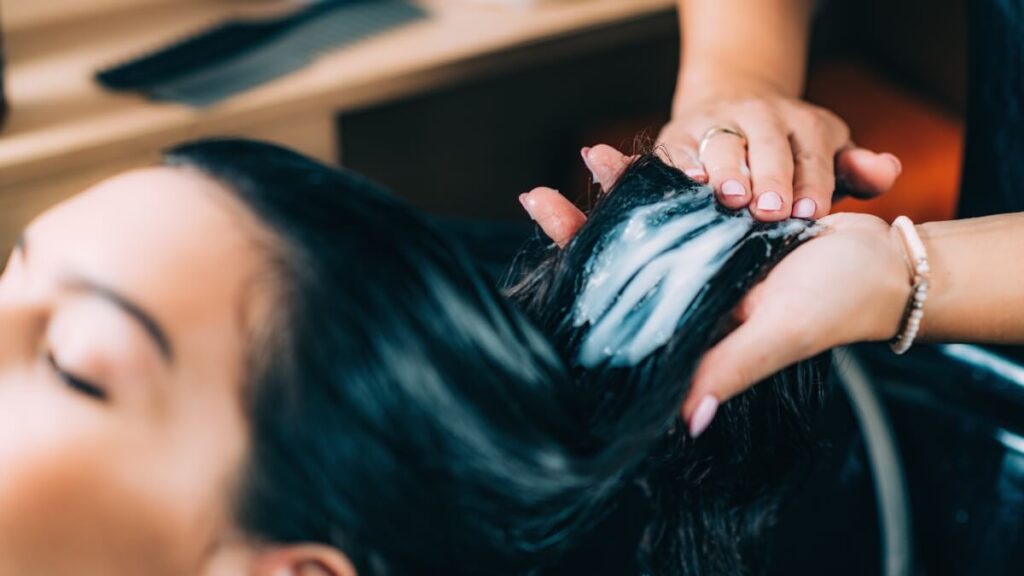
We’ve touched on this already, but let’s get specific about the risks of leaving in conditioners that should be rinsed out.
Your Scalp Can Develop Serious Problems
Product buildup clogs hair follicles, which creates a whole host of issues. You might notice scalp irritation first, including:
- Redness
- Tenderness
- Discomfort
Many people develop a persistent itch that makes them want to scratch constantly, which only makes the irritation worse. You might also see flaking, though this isn’t the same as dandruff. Product-induced flaking happens because of buildup rather than a fungal issue.
In severe cases, you can develop folliculitis, which shows up as small, red bumps on your scalp. This is inflammation of the hair follicles themselves and can be quite uncomfortable.
Disrupting Your Scalp’s Natural Balance
Your scalp has a delicate ecosystem of bacteria and fungi that help maintain its health, similar to your skin’s microbiome. Product buildup disrupts this balance and can lead to overgrowth of certain organisms.
This imbalance often shows up as seborrheic dermatitis, dandruff, or other scalp conditions. Once your scalp’s natural balance is thrown off, you may need specialized treatments beyond regular shampooing to restore scalp health.
What Happens to Your Hair Quality
The most obvious problem is how your hair looks and feels:
- Buildup diminishes the reflective quality of healthy hair, making it appear dull.
- Your hair loses volume and body because of the weight of the product, leaving you with limp, flat hair.
- Even freshly washed hair can look greasy and unwashed due to residual product.
Here’s something many people don’t realize – conditioner residue acts like a magnet for airborne particles, so your hair actually attracts more dirt and environmental pollutants.
Long-term Effects on Hair Structure: Over time, excessive moisture from leftover conditioner can cause hygral fatigue, which weakens the hair fiber. This happens when your hair swells and contracts repeatedly from too much moisture exposure.
Styling Becomes a Nightmare
When you have conditioner buildup, your hair becomes much harder to style. Products don’t adhere properly to hair that’s coated with residual conditioner. The barrier created by buildup prevents styling products from binding to your hair shaft, so nothing works the way it should.
You might find yourself using more and more products to try to combat these issues, which creates a cycle of more product use and more buildup. Heat styling tools also don’t work effectively because residual conditioner can literally “cook” onto your hair when heat is applied.
Long-term Consequences for Hair Health
The effects of consistent conditioner buildup go beyond just appearance problems. You can develop a moisture-protein imbalance where your hair becomes overly soft and weak from too much conditioning without proper protein balance.
Buildup can actually alter your hair’s porosity over time, changing how it absorbs and retains moisture. In extreme cases, severely clogged follicles may impact your hair growth cycle, potentially stunting growth.
There’s also what could be called accelerated aging of your hair. Buildup increases friction between strands, leading to mechanical damage over time. Your hair essentially wears out faster than it should because it’s constantly fighting against the residue coating each strand.
What if I Accidentally Used Regular Conditioner as a Leave-In Conditioner?
This happens more often than you think. Maybe you grabbed the wrong bottle in the shower. Maybe you’re traveling and only packed regular conditioner.
Check Your Hair Type First
How your hair reacts depends on your hair type. Fine hair shows problems fast. Thick hair might look okay at first. The amount you used matters too.
Your hair type affects how this mistake impacts you:
• Fine hair – You’ll probably notice heaviness and greasiness within hours
• Thick or coarse hair – Might not look too bad initially, but problems develop over time
• Curly hair – Could look okay temporarily, but buildup will catch up with you
• Oily hair – This will make things much worse much faster
Quick Fix
If you realize your mistake right away, rinse your hair with cool water. You won’t get all the product out. You can remove some of it though. Focus on your roots and scalp.
Don’t use hot water. This helps the conditioner penetrate deeper into your hair.
Next Day Fix
You need a clarifying shampoo to remove the buildup. Regular shampoo might not work. Fine hair needs extra help removing product.
Your plan:
- Use clarifying shampoo on your scalp and roots
- You might need to shampoo twice
- Use your regular conditioner after (rinse it out this time)
- Use a lightweight leave-in if your hair feels dry
Some people try dish soap or baking soda. These can damage your hair. Stick with clarifying shampoo.
Avoid This Mistake
Keep your regular conditioner and leave-in products in different shower areas. If you’re traveling, label your bottles. Use different colored containers.
Leave-in products can stay outside the shower. This prevents mix-ups when you’re tired.
When You Need Help
If clarifying doesn’t work, see a stylist. If your scalp gets irritated, see a stylist. They have stronger treatments that won’t damage your hair.
Most of the time, one clarifying session fixes the problem. Your hair might feel dry afterward. Be gentle for a few days. Use a deep conditioner during your next wash.
What Happens if You Accidentally Leave Conditioner in Your Hair?
Sometimes you’re in a rush and forget to rinse out your conditioner completely. Sometimes you think you rinsed it all out but didn’t. Here’s what happens next.
Immediate Effects
Your hair will feel different right away. It might feel softer at first, but that changes quickly. Within a few hours, your hair starts to feel heavy and greasy.
Fine hair shows problems fastest. Thick hair might take longer to look bad. Curly hair can hide the greasiness better initially.
What You’ll Notice First
Your hair loses volume. It looks flat and lifeless. Even if you styled it, the style won’t hold. Your hair might look wet even when it’s dry.
The roots are usually the worst part. This is where product buildup is most obvious. Your scalp might start to feel itchy or uncomfortable.
How Long It Takes to Get Bad
With fine hair, you’ll notice problems within 2-3 hours. With thick hair, it might take half a day. Oily hair types will look terrible fast.
Your hair keeps attracting dirt and pollution throughout the day. By evening, it looks worse than it did in the morning.
Quick Fixes That Don’t Really Work
Some people try dry shampoo to absorb the grease. This might help a little bit. It won’t fix the real problem though.
You can try pulling your hair back or putting it in a bun. This hides some of the greasiness. Your scalp will still feel uncomfortable.
What Actually Works
You need to wash your hair again. Regular shampoo might not be enough. You might need:
- Clarifying shampoo for stubborn buildup
- Two rounds of shampooing
- Extra focus on your roots and scalp
- Cool water rinse to remove all traces
Prevention Tips
Rinse longer than you think you need to. Use cool water for your final rinse. This helps remove product better than warm water.
Set a timer if you’re always rushing. Give yourself at least 2-3 minutes to rinse conditioner completely.
Check different sections of your hair. Sometimes one area gets more conditioner than others. Make sure you rinse everywhere.
When It Becomes a Pattern
If this keeps happening, you might be using too much conditioner. You might also be applying it too close to your roots.
Try using less product next time. Focus conditioner only on your mid-lengths and ends. Keep it away from your scalp area completely.
The Ingredients That Matter
Not all conditioners work the same way. Understanding the ingredients helps you make better choices for your hair.
Good Ingredients to Look For
Some ingredients work better than others. Here are the ones that actually help your hair:
Humectants like glycerin, honey, and aloe vera draw moisture into your hair from the air around you. They hydrate your hair without making it heavy.
Emollients include oils and butters that smooth your hair. They lock in moisture by filling gaps in the cuticle. They also create a protective coating on your hair.
Proteins such as keratin, wheat, and silk strengthen and repair your hair. They fill in damaged areas of the hair shaft temporarily.
Quaternary ammonium compounds have long names like behentrimonium chloride and cetrimonium chloride. These ingredients detangle and condition by sticking to your hair shaft. They also reduce static.
Some other helpful ingredients:
- Ceramides – lipid molecules that maintain your hair’s moisture barrier
- Panthenol (Vitamin B5) – penetrates your hair shaft to add moisture and shine
- Bond builders – repair broken bonds in your hair (like Olaplex technology)
Ingredients That Can Cause Problems
Some ingredients create more problems than they solve.
Silicones like dimethicone and amodimethicone can build up over time. The non-water-soluble types are the worst offenders.
Heavy oils such as mineral oil and petrolatum weigh your hair down. They create a barrier that stops moisture from getting into your hair.
Drying alcohols like SD alcohol and ethanol dry out your hair. Fatty alcohols like cetyl and stearyl alcohol are different though – these actually moisturize.
Sulfates like sodium lauryl sulfate strip your hair of natural oils. You’ll find these in some 2-in-1 products.
Formaldehyde-releasing preservatives can irritate your scalp. Look out for DMDM hydantoin and imidazolidinyl urea.
Synthetic fragrances cause irritation and allergic reactions in some people.
The Silicone Situation
Silicones are common in conditioners but people misunderstand them.
There are different types of silicones. Water-soluble ones like dimethicone copolyol and PEG-modified dimethicone rinse out easily with water. Non-water-soluble ones like dimethicone and cyclomethicone need sulfates or clarifying shampoos to remove completely.
Why People Use Silicones: Silicones create smooth, shiny hair. They provide heat protection and reduce frizz. They fill in damaged areas of the cuticle temporarily.
Why People Avoid Silicones: They build up over time. They can prevent moisture from entering your hair shaft. They make hair feel artificially slippery. You need stronger cleansers to remove them.
Whether silicones work for you depends on your hair type and washing habits. People with curly hair who follow the Curly Girl Method usually avoid silicones completely.
Can I Sleep with Conditioner in My Hair?
Sleeping with conditioner in your hair is not a good idea. Regular rinse-out conditioner isn’t designed to stay in your hair for 6-8 hours.
What Happens When You Sleep with Regular Conditioner
Your hair absorbs too much product overnight. This leads to oversaturated hair that feels mushy and weak. You wake up with greasy, flat hair that looks unwashed.
The conditioner also transfers to your pillowcase. This can clog the pores on your face and cause breakouts. Your pillow absorbs the product and holds onto bacteria.
How Many Hours Can I Sleep With Conditioner in My Hair?
You shouldn’t sleep with regular conditioner in your hair at all. Even 2-3 hours is too long for most rinse-out conditioners.
Here’s what happens at different time intervals:
- 1-2 hours – Hair starts to feel heavy and look greasy
- 3-4 hours – Noticeable buildup and loss of volume
- 6-8 hours (overnight) – Severe buildup, potential scalp irritation, very greasy appearance
The longer you leave it in, the harder it becomes to wash out completely.
Deep Conditioners Are Different
Some deep conditioning masks are designed for longer wear. These usually say “leave in for 10-30 minutes” or “can be used as an overnight treatment” on the package.
Even with deep conditioners meant for longer use, overnight application isn’t always necessary. Most reach maximum effectiveness within 30-45 minutes.
What About Leave-In Conditioners?
Leave-in conditioners are fine to sleep with. They’re specifically formulated to stay in your hair without causing buildup or greasiness.
These products have different concentrations of conditioning agents. They’re designed to be absorbed by your hair rather than sitting on top of it.
Better Alternatives for Overnight Hair Care
If you want to treat your hair overnight, try these options:
- Hair oils applied to the ends only
- Silk or satin pillowcases to reduce friction
- Protective hairstyles like loose braids
- Leave-in treatments designed for overnight use
Quick Fix If You Already Did It
If you already slept with conditioner in your hair, wash it out immediately. Use a clarifying shampoo if regular shampoo doesn’t remove all the buildup.
You might need to shampoo twice. Focus on your roots and scalp where the greasiness is worst.
Your hair might feel dry after clarifying. Use a proper conditioner (and rinse it out this time) to restore moisture balance.
When Leaving Conditioner In Is Actually Recommended
We’ve talked mostly about when not to leave conditioner in. But there are times when it can help your hair.
Pre-Shampoo Treatments
Some people apply conditioner before shampooing. This is called “pre-poo.” You leave it on for 15-30 minutes before washing your hair.
The conditioner creates a protective barrier that stops shampoo from stripping too much moisture from your hair. This helps people with curly, coily, or very dry hair.
Focus the conditioner on your mid-lengths and ends. You can add oils for extra protection. Then shampoo normally afterward.
Overnight Hair Masks
Certain deep conditioners work for overnight use. These are labeled as “overnight masks” or “sleeping treatments.” Regular conditioners don’t work this way.
These special products slowly release conditioning agents all night. They don’t cause buildup or scalp problems like regular conditioners would.
Tips for overnight treatments:
- Use only products labeled for overnight use
- Protect your pillowcase with a silk or satin cap
- Keep the product on mid-lengths and ends only
- Rinse thoroughly in the morning
Swimming Protection
Apply leave-in conditioner before swimming. This protects your hair from chlorine and salt water damage.
The conditioner blocks chlorine or salt from getting into your hair shaft. This prevents drying and damage.
Apply the conditioner generously before you swim. Wear a swim cap for extra protection. Rinse well after swimming. Use a clarifying shampoo if needed.
Curl Definition Methods
Many people with curly hair use the “squish to condish” method. You don’t rinse all the conditioner out. This helps define curls.
The leftover conditioner keeps curls hydrated and defined. It acts like a light styling product.
Use a lightweight conditioner for this method. Rinse partially but not completely. Scrunch your hair while rinsing to encourage curl formation. Add other styling products if you want.
Detangling Severely Knotted Hair
For very tangled hair, conditioner helps during detangling. The slip from conditioner helps combs and brushes glide through knots. You get less pulling and breakage.
Apply conditioner generously to wet hair. Let it sit for a few minutes to soften tangles. Use a wide-tooth comb or detangling brush. Start from the ends and work up to the roots. Rinse thoroughly when you’re done detangling.
How to Know If You’re Over-Conditioning
Not sure if you’re giving your hair too much of a good thing? Your hair will tell you.
Signs You’re Using Too Much Conditioner
Over-conditioned hair behaves differently than healthy hair. Here’s what to watch for:
Your hair feels mushy or gummy when it’s wet. This happens when excessive moisture makes your hair lose its structure and elasticity.
Your hair becomes too soft to hold any styles. It has no body or volume. Products slip off instead of sticking to your hair shaft.
You might notice increased breakage or snapping. This happens when moisture overload disrupts the protein-moisture balance your hair needs.
Other warning signs:
- Hair doesn’t seem to fully dry even hours after washing
- Limp, flat appearance, especially at the roots
- Greasiness shortly after washing – clean hair looks dirty
- Regular shampoo doesn’t get your hair clean anymore
- Scalp itchiness or irritation from product buildup
Try the Strand Test
A simple way to check for over-conditioning is the strand test. This works on any hair type.
When your hair is wet, select a single strand. Gently pull the strand between your fingers and stretch it slightly. Watch what happens when you let go.
What the results mean: If your hair stretches a lot and doesn’t return to its original length, you have moisture overload from too much conditioning. If it breaks when you stretch it, the problem is even worse.
Healthy hair should stretch about 30% of its original length and then return to normal when you release it.
If your hair barely stretches and snaps quickly, you have the opposite problem. This means protein overload or not enough moisture. You need more conditioning, not less.
When to Do This Test
Do the strand test monthly or whenever you notice changes in your hair. This simple test helps you adjust your routine before serious damage happens.
Test multiple strands from different parts of your head. Different sections of your hair may have different needs.
The strand test works especially well for curly and textured hair. These hair types need proper
The Bottom Line: To Leave In or Rinse Out?
After all this discussion, here’s some straightforward advice.
The Simple Rules
Read the label first. If it says “rinse out,” do it. Don’t try to outsmart the product formula.
Know your hair type. Fine hair needs less conditioning and more thorough rinsing than thick or curly hair. Your hair type determines how much product you can handle.
Use products as intended. Leave-in conditioners are made to stay in your hair. Regular conditioners are not. The formulations are completely different.
Start Small
Less is more with conditioning products. Start with a small amount and add more if you need it. Don’t go overboard from the start.
Most people use too much conditioner rather than too little. You can always add more product, but removing excess is much harder.
Pay Attention to Your Hair
Listen to what your hair tells you. If it feels heavy, looks greasy, or isn’t behaving normally, you might be over-conditioning.
Your hair will show you when something isn’t working. Don’t ignore the signs just because you think more conditioning should be better.
Healthy hair routines are about balance, not about using as much product as possible.
What’s the Right Way to Use Hair Conditioner?
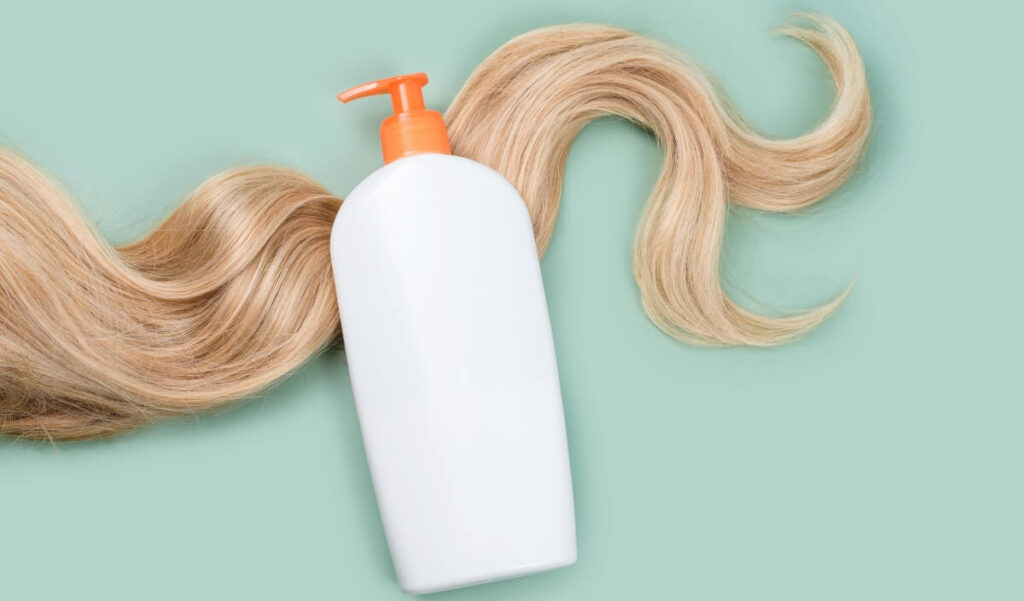
Using conditioner correctly makes a huge difference in how your hair looks and feels. Here are some do’s and don’ts:
- Apply conditioner only to the mid-lengths and ends of your hair.
- Avoid your roots and scalp completely unless you have very dry, curly hair.
- Use a wide-tooth comb or your fingers to distribute the product evenly. You want every strand to be coated and you don’t want too much on one area of your hair.
- Leave the conditioner in for 1-3 minutes before rinsing. Conditioner needs time to get into the hair shaft. Use cool water to rinse out your hair, as this seals up your cuticle.
How Often Should You Use Conditioner?
It depends on your hair and your lifestyle.
Most people need conditioner:
• Every time they shampoo (2-3 times per week)
• Every day if their hair is damaged or excessively dry
If you have fine or oily hair you’re not going to need conditioner as often.
People with curly or coily hair often condition more than they shampoo. They might use a cleansing conditioner between regular washes. They might also use a leave-in conditioner each day.
In general, you should pay attention to how your hair feels. If it’s dry and tangled, condition more often. If it’s limp and greasy, use less conditioner.
Frequently Asked Questions
Are there benefits to leaving conditioner in my hair overnight?
Only if you’re using a product specifically designed for overnight use. You can irritate your scalp if you leave regular conditioner in too long. If you need overnight conditioning, use an overnight mask.
Is leave-in conditioner bad for your hair?
No, leave-in conditioners are designed to stay in your hair without causing buildup. These products can benefit most types of hair, especially dry, damaged, or curly hair. You just need to make sure to use the right amount for your hair type.
Can I use regular conditioner as a leave-in?
This is not a good idea. Regular conditioners aren’t formulated to be left in and can cause buildup and other issues.
How long can I leave deep conditioner in my hair?
Follow the instructions on the package. Typically, you leave it in for 10-30 minutes. You’re not going to get much benefit from leaving it in longer.
Is it better to condition for 3 minutes or 30 minutes?
For regular conditioners, 3-5 minutes is usually sufficient. For deep conditioners, follow the directions on the product or packaging.
Can I sleep with conditioner in my hair?
Just if it’s specifically labeled as an overnight treatment. Otherwise, you need to rinse it out before going to sleep.
How often should I deep condition my hair?
Once a week for damaged hair, once every two weeks for normal hair.
Can leaving conditioner in cause hair loss?
It’s not the conditioner itself that’s the problem. Leaving conditioner in creates buildup that clogs hair follicles. This could damage the scalp in such a way that it affects your hair growth.
Is it bad to use conditioner every day?
It depends. Many people benefit from daily conditioning, especially those with dry or curly hair. The key is using the right type and amount for your hair.
Is it OK to leave a little conditioner in your hair?
Fine hair can’t handle it. Thick or curly hair is different though. It can actually make your hair healthier.
Are there conditioners that help support hair growth?
Conditioners don’t directly make hair grow faster. They can create healthier conditions for growth though. Also, biotin, caffeine and peptides in conditioners can make your scalp healthier.
What temperature water should you rinse your hair with after using conditioner?
Cool water works best. It seals the hair cuticle and adds shine. Plus it gets all the product out. Hot water leaves residue behind and makes hair look dull.
How much time does it take to deep condition your hair?
About 10 to 20 minutes, but there are some deep conditioning treatments that take about a half hour.
Ready for a new hair style or just need a touch up? What about extensions?
Societe Salon provides expert hair styling in a luxurious environment. Book your appointment today with one of our experienced stylists.
